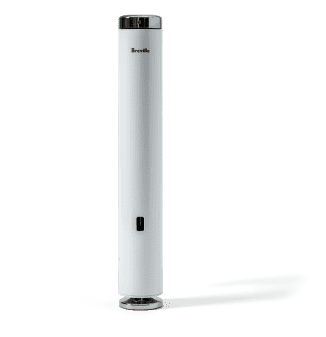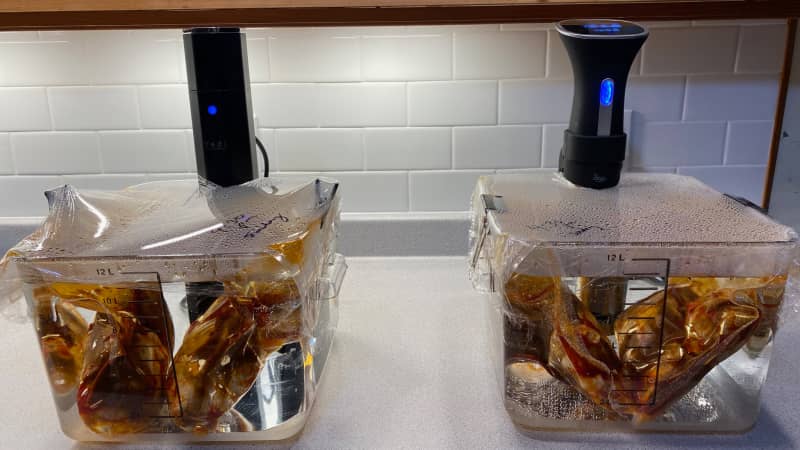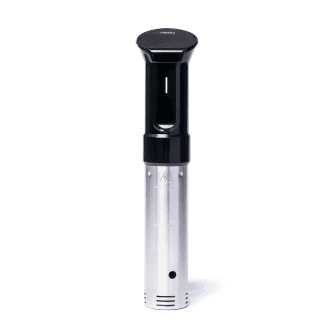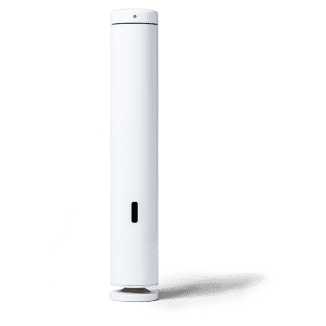Sous vide cooking is easy, if you have the right immersion circulator. We compared the speed, accuracy, ease of use, and cooking results of several new models. The Breville Joule Turbo Sous Vide is our top pick. Simple to set and easy to clip on a variety of vessels, it heated water rapidly and kept the temperature right on target, whether we were cooking for 12 minutes or 20 hours. Everything from eggs to asparagus to steak to pulled pork emerged perfectly cooked. The smallest, most compact model in our lineup, it’s easy to store, and its app is very user-friendly. Our Best Buy is the Yedi Houseware Infinity Sous Vide. While it’s bigger and bulkier to store and a bit less efficient to read with its high, flat display, it heated accurately and circulated water powerfully, with excellent results.

A sous vide immersion circulator is a sticklike appliance that heats water in a vessel to a desired temperature and then maintains that temperature to cook food immersed in the water bath. The food, which is first sealed in plastic (though not always; you can cook sous vide in glass jars, and eggs can be cooked right in their shells), eventually reaches the same temperature as the water, so it can’t overcook. With meat, poultry, and fish, you usually follow up with a quick sear in a skillet for surface browning.
The benefits of sous vide cooking are perfectly and uniformly cooked food and a process that’s quiet, neat, and mostly hands-off. Cleanup is minimal, because you’re cooking your food in water. And because they’re not cooked directly in the water, vegetables such as carrots and asparagus come out intensely flavorful and stay brightly colored. Sous vide cooking can also be long, slow, and gentle, turning tough cuts of meat fork-tender.
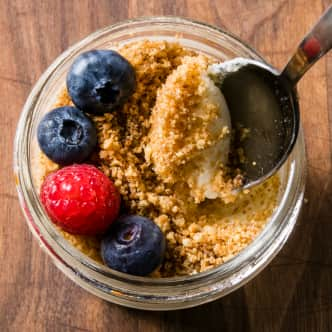
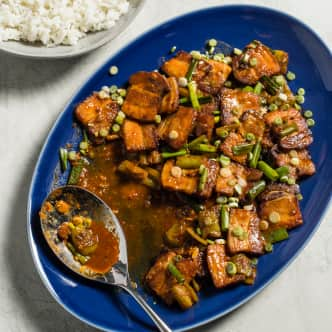
Sous vide isn't just for steak and eggs. Check out our recipes for Sous Vide Upside-Down Cheesecake Cups, Sous Vide Sichuan Twice-Cooked Pork Belly, and more.
What To Look For
- Accuracy: The device must heat and hold water at a precise temperature; accuracy is everything in sous vide cooking.
- Speed: Our favorites rapidly reached the target temperature, shaving off many minutes of waiting around to begin cooking. Especially with short recipes such as poached eggs, faster-heating devices made a dramatic difference in the total cooking time.
- Power: Devices that were more powerful circulated the water more efficiently, spreading the heat to maintain a uniform temperature in the bath.
- Simple, intuitive controls: Setting time and temperature should be easy and quick.
- Easy-to-read display: Being able to monitor progress without waiting for rotating displays or interpreting cryptic readouts was a major plus.
- Attachments that adapt to a variety of vessels: Whether we were cooking in an 8- or 12-quart plastic container, a 7.25-quart Dutch oven, or a large saucepan, our top models attached quickly and securely. We preferred devices with clothespin-like clips because we could secure them in place faster than those models with screw-on attachments. Our top model even has a magnetic base, so it can stand independently in metal pots.

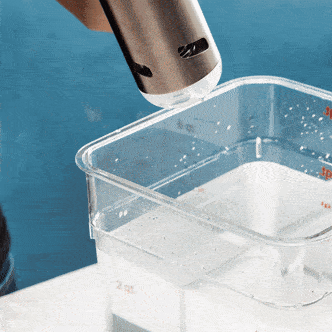
Nice to Have
- User-friendly app: Two models are app operated, though one required the use of the app and the other also had controls on the machine. Our top choice has a simple, efficient app that let us set the device without fuss and monitor progress or make adjustments from afar. (The other, not so much; see below.)
- Compact size: Being able to store the device easily between uses without worrying about a bulky profile was a bonus.
- Higher wattage: Our top models had 1,000 watts of power or more at their disposal, helping them heat water and circulate it more efficiently.
What To Avoid
- Inaccurate heating: Sous vide devices that don’t quite hit and hold the target temperature are frustrating. A single degree or two off target doesn’t matter much in an hours-long project such as pulled pork, but we found that even this small level of inaccuracy can affect food texture when preparing fast-cooking eggs or delicate vegetables such as asparagus. It’s a good idea to check the accuracy of your device with a separate thermometer; if the water temperature is consistently off, you’ll always need to adjust the setting up or down accordingly.

- Inefficient attachment modes: Circulators that attached to cooking vessels with screw-on clamps were more tedious to use than those with clips and they didn't fit as wide an array of vessels, including key pots such as a large saucepan or a Dutch oven. The screw-on device of one model was permanently positioned too high, making it impossible to attach the device to smaller pans. The placement of another model’s clamp made the device sit at an awkward angle when we attached it to a small pot or Dutch oven; sous vide circulators should be positioned upright in a vessel to work properly.
- Confusing, tedious controls: Sure, you’ll get used to whatever device you choose, but the controls of some models were annoying and time-consuming to set. To select cooking times or target temperatures, we had to hold down arrows or repeatedly push buttons to scroll up or down; this was especially annoying when trying to select a 20-minute cooking time on models that started with defaults of 4 hours or longer. Another left us hanging for many seconds once we’d apparently set the time and temperature, and if we pushed the arrow again to get it started, it shut off. You get the drift.
- Displays that were hard to interpret: One model used the same display to show hours/minutes and temperature, so it always took us a second to figure out what we were looking at (Is that 18:00 hours or 180.0 degrees?).
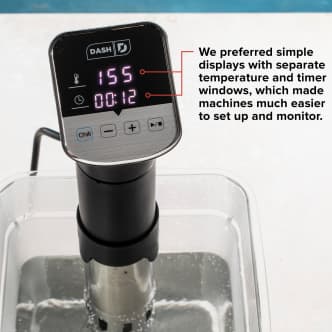
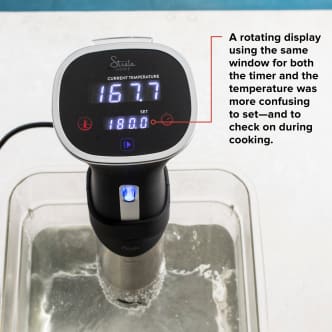
- User-unfriendly apps: One model’s app kept losing connection with the device, which was very annoying when we wanted to change the timer, stop cooking, or check progress from another room (it happened repeatedly). Despite its user-friendly design, recipes, and tips, this frustrating app wasn’t worth it. When it was working, it allowed us to set exact desired times and temperatures. When it wasn't, we had to rely on the device's manual controls to set the timer, but we were limited to increments of 5 minutes—not too helpful when making a 12-minute egg.
The Tests
- Prepare Sous Vide Soft-Poached Eggs, Sous Vide Seared Steaks, Sous Vide Perfect Asparagus, and Sous Vide Indoor Pulled Pork with each model, evaluating the devices’ performance, accuracy, ease of use, and their sturdiness of construction
- Time how long it takes each device to heat 6 quarts of water in a Cambro plastic food storage container from 60 degrees to 160 degrees
- Compare the accuracy of the display thermometer on each device against two other calibrated thermometers, checking the water temperature in various locations throughout the vessel
- Compare water-circulation efficiency: Using single drops of yellow and blue food coloring, time how long it takes each device to turn 6 quarts of water uniformly green
How We Rated
- Performance: We rated the machines on the quality of the food they produced as well as their ability to cook a variety of recipes.
- Speed: We rated the speed at which each model brought water to our desired cooking temperature.
- Accuracy: We compared the displayed temperature on each device to the readings from two separate calibrated thermometers at several points during our cooking projects as well as in several spots within each cooking vessel.
- Ease of Use: We evaluated how easy the devices were to handle, attach to a cooking vessel, and set and how easy it was to monitor progress and make changes to the settings. Where available, we also assessed the ease of working with the device’s app.
- Sturdiness: We assessed each device’s construction as we used and handled them.

